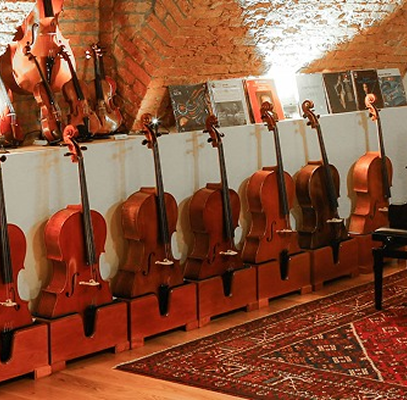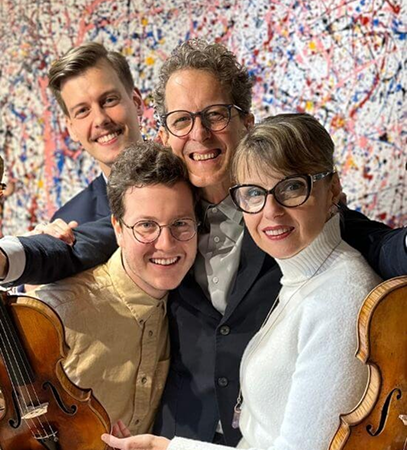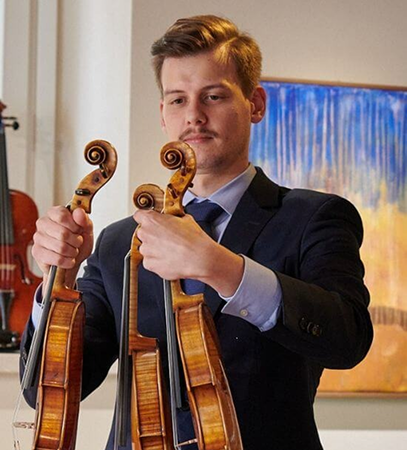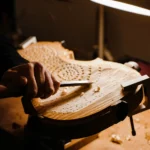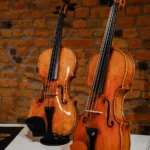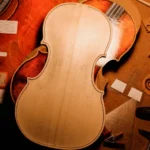The World of Violin Luthiers
Back to BlogThe World of Violin Luthiers: Crafting Sound and Tradition
For the naked eye, the violin is merely a musical instrument, but for the passionate violinists, it is a legacy of craftsmanship, innovation in sound, and artistry. The violin luthier is the mastermind behind every fine tool. These mix tradition and innovation to form instruments that leave no stone unturned in inspiring musicians and collectors. Hence, whether you are a violinist searching for the ideal tone or a connoisseur looking for some rare artistry, understanding the world of violin makers is crucial, as only then will you appreciate them more.
Want to discover? This blog will spill the beans from Cremonese masters to modern artists like Luiz Amorim, and other details.
What Does a Violin Luthier Do?
A luthier for violins is a craftsman who shares expertise in the manufacturing, restoring, and maintaining violins and other string instruments. As far as the violin construction process is concerned, the method consists of complicated steps, where the artisans select premium-quality woods, carve, assemble, varnish, and fine-tune each violin until it’s perfect to play and hear.
Besides stunning you with new instruments, violin luthiers are also into repairing and maintenance. They rehair bows, adjust sound posts, and even restore historic violins. Their work impacts every aspect of the instrument’s tone, balance, and vibrancy. From amateurs, students to soloists performing in big and small concerts, everyone depends on the skill of a violin maker so they can amaze the audience with the best sounds.
A Brief History of Violin Making
Violin craftsmanship goes back to Italy in the 16th century. During the Renaissance, the creators began to refine the form and acoustics of instruments consisting of bowed strings, resulting in the development of the modern violin. The golden time of violin making was defined by names such as Andrea Amati, Gasparo da Salo, and later Antonio Stradivari and Giusseppe Guarneri.
These violin makers not only created instruments but also set standards of quality that modern violin luthiers still look up to and try their best to mix time-honored practices with the latest technologies and research on acoustics.
Cremona: The Heart of Violin Craftsmanship
When you discuss fine violins with anyone, they will talk about Cremona, Italy. Why? The primary reason is that this city is home to the legendary Cremona violin makers such as Stradivari, Guarneri, and Bergonzi. And to this day, Cremona secures the title of remaining the spiritual and educational hub for violin luthiers worldwide.
Furthermore, a Cremona violin workshop is famous for passing the skill and classical techniques to the new generations, seeking to learn the art of crafting string instruments. Not only workshops but also schools in Cremona teach violin making, the education goes beyond how to build violins, as they are also taught to respect wood, the sound quality, and the requirements of the musicians, which they have to follow. Stepping into Cremona is like coming into a living museum, where violin craftsmanship breathes. You will come across multiple workshops lined in small streets, offering a glimpse into the centuries-old procedure of creating sound through wood, strings, and soul.
Luiz Amorim and the Revival of Contemporary Excellence
Who’s Luiz Amorim?
Luiz Amorim is among the top contemporary violin makers. Based in Cremona, Italy, his work gained international acclaim while bridging the gap between traditional violin craftsmanship and the art of antiquing and copies.
The fascinating part is that Amorim’s violins are celebrated for their visual artistry and tone quality. The new generation, who want instruments because of their sound and to portray individuality, find them more appealing. Amorim’s career displays the style of modern violin luthiers, who can bring in new changes while honoring tradition and balancing precision with passion.
The maker’s work shows that being one of the best violin luthiers doesn’t require copying the past; it demands understanding the depths of making and building something inviting and distinct, that look and sound at its best.
Choose a Violin Maker: What to Look For?
You might have searched for a violin luthier near me or abroad to lay your hands on the best violin maker. Here are a few things to keep in mind before closing your deal with them:
Reputation Of The Luthier
The internet will fill your feed with several names, but you must remain vigilant. While shortlisting luthiers, read the reviews to see how many other like-minded aspiring luthiers have recommended their style of teaching and credentials. Members belonging to national and international luthier academies and associations meet high standards, hence it’s better if you learn from them.
Materials and Technique
Check the materials and technique. This involves the quality of tonewoods, polishing methods, and precise carving that all impact the final sound of the violin.
Sound and Playability
Testing the tool for responsiveness, tone color, and comfort for the player is vital. A professional violin maker designs the instrument in such a way that the particular player uses the same violin on every stage.
Service and Support
What defines a good violin workshop? Well, it offers the necessary services and support. You can contact them to adjust and get guidance related to your purchase.
If you buy directly from a luthier for violins, you can access tailored adjustments and insights into the violin’s roots and craftsmanship.
Commissioning or Buying: A Collector’s Perspective
From a collector’s perspective, obtaining a violin is as much about artistry as sound. Some are crazy for antique instruments due to their historical value. In contrast, others buy contemporary violins by modern violin luthiers because of their surging value in the market and the fact that they are widely available.
Therefore, there is an option of commissioning a personalized instrument that permits collectors to share the seat and work closely with a violin maker to create unique outcomes. They pick wood, shape, and finishing style with the tonal goals. In short, the whole violin construction process becomes a partnered journey, leading to an instrument that ticks off both personal and masterful requirements.
So, whether you buy from Cremona violin makers or famous names such as Amorim, the collector’s goal is to store those pieces that explain the violin craftsmanship of their time.
The Future of Violin Making
Wondering about the future of violin making? You need not stress, as the industry is not going to see its end. The next generation of contemporary violin makers is adopting sustainability, participating in global events, and understanding scientific acoustics. These are playing a massive role in boosting the acoustic of new violins. CT scans and 3D modeling are also used to analyze how old violins were made at that time to mimic their latest models.
However, despite so many advancements, nothing can beat Cremona, the heart of violin craftsmanship. The violin luthier uses their magical touch, eyes, and ears to present the final result in front of you.
No matter how much technological advancement, a violin luthier will always remain at the top of their game, offering and teaching you the skills needed to make a violin. Furthermore, you can always avail yourself of the custom commission service from modern luthiers like Amorim Fine Violins to learn the art of creating the wooden musical instrument with strings.

